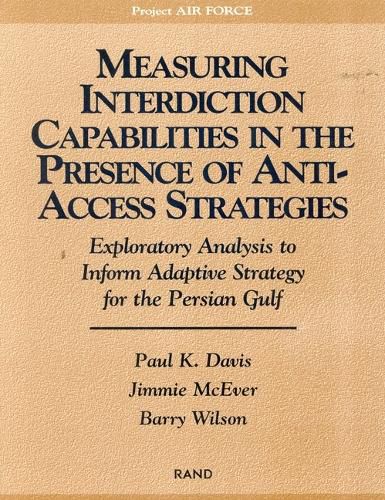Readings Newsletter
Become a Readings Member to make your shopping experience even easier.
Sign in or sign up for free!
You’re not far away from qualifying for FREE standard shipping within Australia
You’ve qualified for FREE standard shipping within Australia
The cart is loading…






Analytical methods for capabilities-based planning of interdiction missions and models to implement the methods. This book discusses how U.S. capabilities for interdicting invading ground forces in the Persian Gulf can be adapted over time to maintain the ability to achieve an early halt or to counter maneuver forces in other plausible campaigns. The authors emphasize exploratory analysis under massive uncertainty about political and military developments and about the detailed circumstances of conflict. The book documents a specialized model used for mission system analysis, which helps identify critical enablers of early-halt capability: deployment; immediate command-control, intelligence, surveillance, and reconnaissance; ability to employ interdiction forces quickly; and weapon effectiveness. The United States should expect threatened or actual use of mass-casualty weapons against its forces and regional allies and enemy attempts to act quickly and with short warning. On the other hand, the threat’s size and quality may be less than usually assumed. On the military side, the book characterizes parametrically the conditions for a successful early halt, thereby identifying high-priority strategic hedges, capability developments, and potential adaptations. The book considers joint forces for interdiction and synergy with rapidly employable ground forces. On the political side, the book notes the premium on continued forward basing, aggressive use of ambiguous warning, and long-range bombers. Continued enforcement of red-line constructs could greatly improve the likelihood of decisive response to ambiguous warning. Countering anti-access strategies would be enhanced by negotiating use of more distant bases and logistic preparation. It will be increasingly unwise to assume use of forward bases, even if technical analysis suggests that the bases could operate under attacks with mass-casualty weapons. [PD]
$9.00 standard shipping within Australia
FREE standard shipping within Australia for orders over $100.00
Express & International shipping calculated at checkout
Analytical methods for capabilities-based planning of interdiction missions and models to implement the methods. This book discusses how U.S. capabilities for interdicting invading ground forces in the Persian Gulf can be adapted over time to maintain the ability to achieve an early halt or to counter maneuver forces in other plausible campaigns. The authors emphasize exploratory analysis under massive uncertainty about political and military developments and about the detailed circumstances of conflict. The book documents a specialized model used for mission system analysis, which helps identify critical enablers of early-halt capability: deployment; immediate command-control, intelligence, surveillance, and reconnaissance; ability to employ interdiction forces quickly; and weapon effectiveness. The United States should expect threatened or actual use of mass-casualty weapons against its forces and regional allies and enemy attempts to act quickly and with short warning. On the other hand, the threat’s size and quality may be less than usually assumed. On the military side, the book characterizes parametrically the conditions for a successful early halt, thereby identifying high-priority strategic hedges, capability developments, and potential adaptations. The book considers joint forces for interdiction and synergy with rapidly employable ground forces. On the political side, the book notes the premium on continued forward basing, aggressive use of ambiguous warning, and long-range bombers. Continued enforcement of red-line constructs could greatly improve the likelihood of decisive response to ambiguous warning. Countering anti-access strategies would be enhanced by negotiating use of more distant bases and logistic preparation. It will be increasingly unwise to assume use of forward bases, even if technical analysis suggests that the bases could operate under attacks with mass-casualty weapons. [PD]